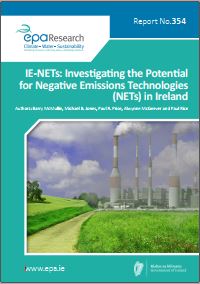Authors: Barry McMullin, Michael B. Jones, Paul R. Price, Alwynne McGeever and Paul Rice
Summary: It is now scientifically understood that effective climate action sets a finite limit on total future net emissions of carbon dioxide (CO₂) from human activities, and may require dependence on large-scale “negative emissions” or CO₂ removal from the atmosphere. The IE-NETs project provides the first review of the technical potential for CO₂ removal in Ireland and an assessment of the security of long-term carbon storage.

Watch the project highlights video
The IE-NETs project applies the most recent scientific understanding that effective climate action requires setting a finite limit on total future net emissions of carbon dioxide (CO₂) due to human activities. This is true at the global level, but it also translates directly to local and national levels for climate action in Ireland, as it relates to CO₂, the single largest contributor to human-caused global warming. The analysis reveals the acute pressure to fundamentally alter all those activities in our society that currently release CO₂ to the atmosphere. These activities are dominated by the use of fossil fuels, which is both pervasive in our ongoing activities (transport, heating, electricity) and embodied in our infrastructure and virtually all of the products that we currently produce and consume.
This framing of climate action in the context of cumulative net CO₂ emissions provides a powerful new lens through which to understand and assess the interactions between short-, medium- and long-term climate mitigation policies. In particular, it allows an integrated assessment of actions that would reduce direct, gross emissions of CO₂ to the atmosphere and complementary actions that might actively remove CO₂ from the atmosphere – so-called negative emissions technologies or NETs. This project has provided the first preliminary assessment of the technical potential for NETs deployment in Ireland. It also provides assessments of Ireland’s prudent, minimally equitable, Paris-aligned national CO₂ quota and expected cumulative CO₂ emissions on the basis of existing policy approaches. This has identified a significant gap between mitigation that is currently regarded as feasible, and what appears to be required to discharge even our minimal “fair share” international contribution in responding to the global climate emergency.
This project has reviewed the approaches to NETs that currently appear to have most potential for deployment in Ireland: afforestation, enhanced soil carbon sequestration, biochar, bioenergy with carbon capture and storage, direct air carbon capture and storage and enhanced weathering of rock materials. It has developed an assessment of technical potential for the scale, timing and security of long-term carbon storage that each might offer. It has applied novel, high-resolution, modelling, incorporating detailed biological mechanisms, to better understand the potential for scaling up indigenous bioenergy production, and the possible interaction with local climate change. It has also
developed a portfolio of coarse-grained scenarios for the future development of the Irish energy system, under strict national CO₂ quota constraints (with and without overshoot), to better characterise the interactions between supply-side decarbonisation, demand-side constraint and NETs deployment. Taken together, these results provide the basis for a set of recommendations to inform public understanding and support a national policy response that is commensurate to the scale of the climate challenge.